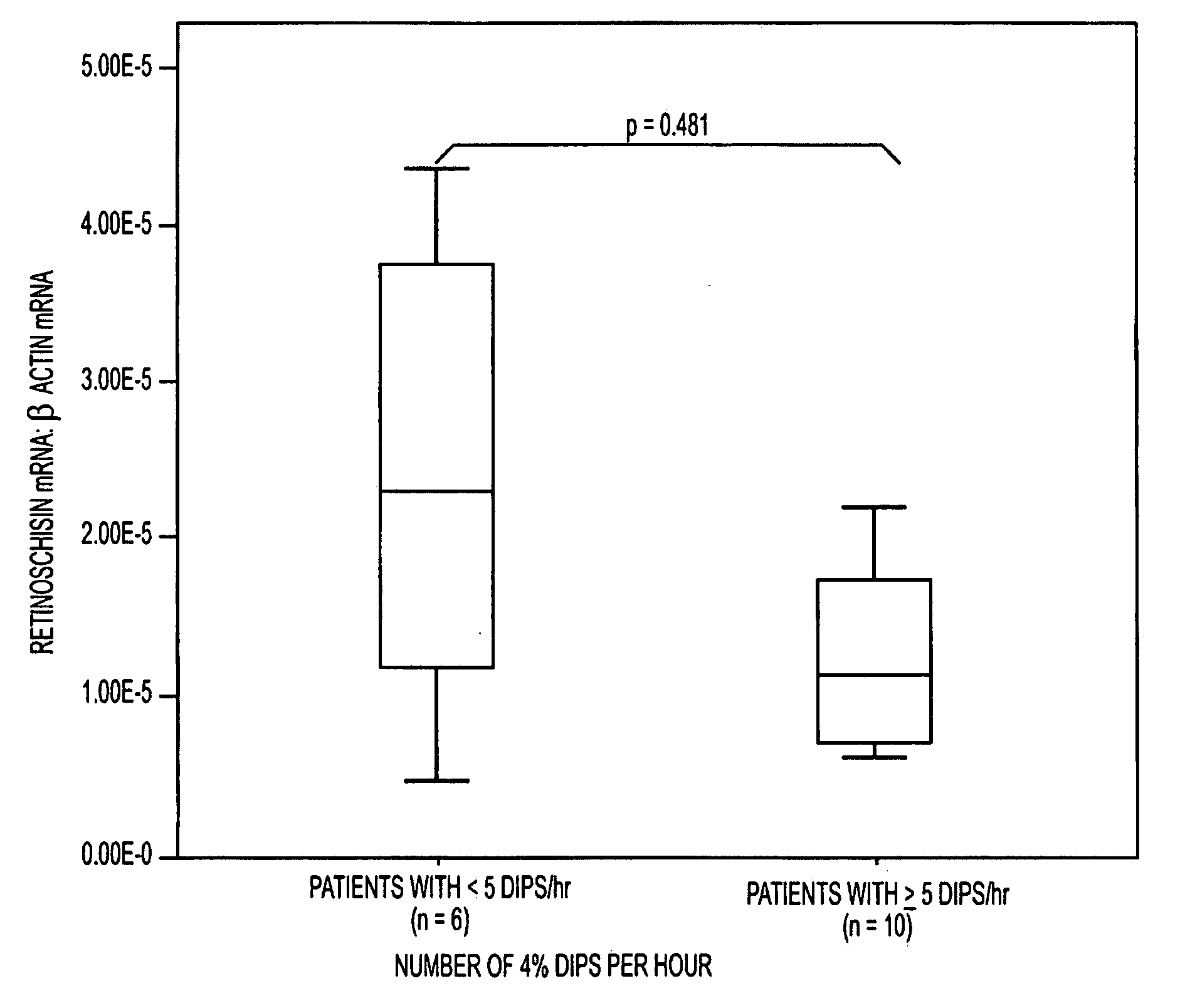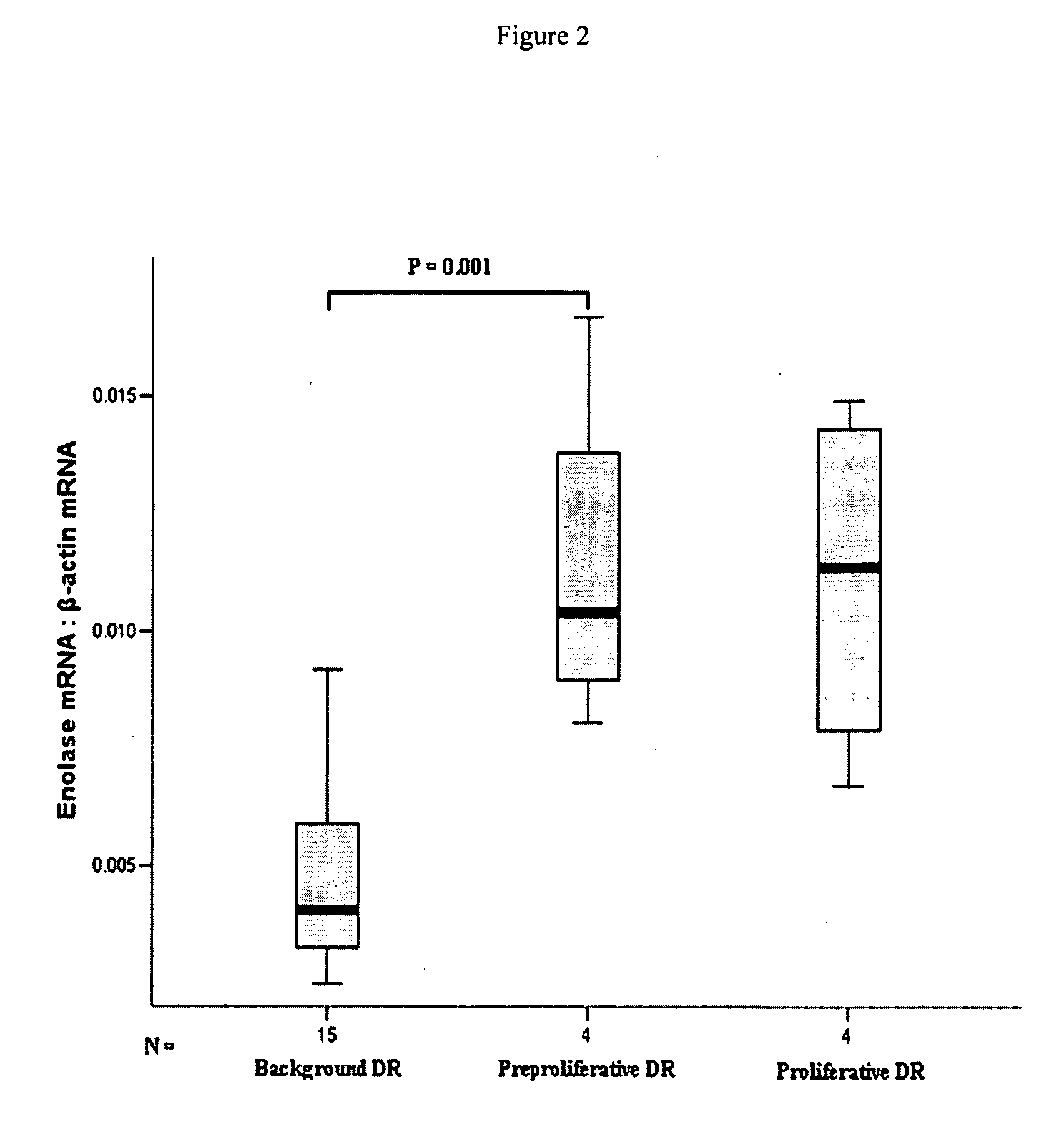Biomarkers
a biomarker and marker technology, applied in the field of biomarkers, can solve the problems of diabetes retinopathy, blindness in the developed world, and a major global health challenge, and achieve the effect of rapid and early detection
- Summary
- Abstract
- Description
- Claims
- Application Information
AI Technical Summary
Benefits of technology
Problems solved by technology
Method used
Image
Examples
example 1
Measurement of Circulating Neuron-Specific Enolase mRNA in Diabetes Mellitus
Summary
[0087]In this study we measured the levels of neuron-specific enolase mRNA as a possible marker of diabetic neuropathy. Blood samples were collected from healthy controls (n=26), diabetic controls (no known neuropathy or retinopathy) (n=22), and diabetics with clinically diagnosed neuropathy (n=24) into PAXgene blood RNA tubes. mRNA was extracted, reverse-transcribed to cDNA, and measured by real-time quantitative PCR. Enolase mRNA levels were normalized by the simultaneous measurement of β-actin mRNA. The results showed that the enolase mRNA was significantly (P=0.002) higher in the diabetic control (median=0.018; range=0.006-0.037) group compared to healthy subjects (median=0.0086; range=0.0016-0.039). However, the diabetic neuropathy group showed lower enolase levels (median=0.0067; range=0.0025-0.017) compared to both healthy subjects (P=0.06) and diabetic controls (P<0.001). In the diabetic neuro...
example 2
Retina-Specific mRNA in the Assessment of Diabetic Retinopathy
Summary
[0125]In the present study we investigated three retina-specific markers in blood to determine their suitability as markers of diabetic retinopathy (DR). The markers were RPE65, retinoschisin, and melanopsin. Whole blood was collected from diabetic patients and healthy controls into PAXgene Blood RNA tubes and RNA was extracted using the PAXgene Blood RNA System. Quantitative real-time PCR was used to quantify mRNA for RPE65, retinoschisin, and melanopsin. β-actin mRNA was used for normalization. RPE65, retinoschisin, and β-actin mRNA were detected in 100% of subjects; melanopsin was not detected in either controls or diabetic patients. Circulating RPE65mRNA concentration was 63% higher in diabetic patients than in healthy individuals (P=0.019), whereas retinoschisin showed no change between the two groups. Compared with healthy controls, circulating RPE65 mRNA concentration was higher in diabetics with no retinopa...
example 3
Effect of Hypoxia on Circulating Levels of Retina-Specific Messenger RNA in Type 2 Diabetes Mellitus
Summary
[0142]Circulating rhodopsin mRNA levels are higher in diabetic retinopathy (DR). Recent evidence suggests that hypoxia may also be associated with DR. The aim of this study was to investigate the effect of oxygen desaturation on circulating retina-specific mRNA in type 2 diabetic patients. Thirty-five type 2 diabetic patients underwent overnight oximetry. Two parameters from oximetry were used to measure oxygen desaturation: the number of times per hour the oxygen saturation decreased by 4% or greater (number of dips / hr) and percentage of sleep time with oxygen saturation (SpO2)<90%. Blood samples were collected into PAXgene Blood RNA tubes. Total RNA was extracted from the samples and reverse-transcribed into cDNA, and retina-specific markers were measured by quantitative real time PCR. In patients with ≧5 dips / hr, mRNA values for rhodopsin (P=0.05) and RPE65 (P=0.044) were si...
PUM
| Property | Measurement | Unit |
|---|---|---|
| temperature | aaaaa | aaaaa |
| volume | aaaaa | aaaaa |
| biological half life | aaaaa | aaaaa |
Abstract
Description
Claims
Application Information
 Login to View More
Login to View More - R&D
- Intellectual Property
- Life Sciences
- Materials
- Tech Scout
- Unparalleled Data Quality
- Higher Quality Content
- 60% Fewer Hallucinations
Browse by: Latest US Patents, China's latest patents, Technical Efficacy Thesaurus, Application Domain, Technology Topic, Popular Technical Reports.
© 2025 PatSnap. All rights reserved.Legal|Privacy policy|Modern Slavery Act Transparency Statement|Sitemap|About US| Contact US: help@patsnap.com



